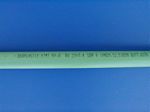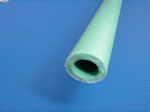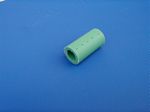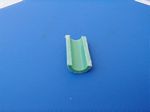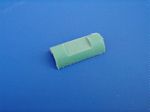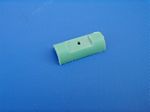Final
1
2
This antenna insulators or
holders idea is mainly dedicated to all Hams building DK7ZB style designed yagis.
Known design include Wimo plastic insulators for 15mm or 20mm boom. Looking
and searching on the web, I found that original insulators a realy expensive
and can be found only in Germany. Between many types of homebrewed insulators
and modified TV antenna parts I come out with this very simple and cheap solution.
Final step shown on the picture is fixed to the 20x20 mm boom with 3mm dia screw
and secured with the washer and nut on the other side. Well known design ground
to the boom only the small portion (3 mm) of the element instead of whole boom
(20 mm) surface.
Buy the plastic pipe designed
for plumbing which can be found in any hardware or plumber store. Calculate
the overall length based on number of required insulators. Each insulator is
40mm long, so for 10 elements yagi antenna you need at least 20cm pipe.
Between many standard dimensions
take the one with 12mm inner diameter to alow 10 or 12mm element diameter to
be secured properly. For bigger diameters use the higher standard measures. For smaller element diameters like 8mm, 6mm use another method.
Cut the pipe in 40mm long pieces
(for 20mm boom), or 35mm (for 15mm boom). This length will ensure enough strength
to prevent rotation of the elements. Longer insulators a not required, because
of detuning effect, specialy on the 432Mhz and higher.
3
4
5
6
Cut the piece of pipe to split
the same in two identical pieces like shown on the picture. This step will require
precision in cuting to allow use of both splited parts. If not form the required
part with the file. Clear all edges with sharp knife.
Antenna
insulators for DK7ZB antenna builders
Depending
of the boom size that you intent to use, form the notch, to fit properly to
the boom. Pay attention not to file notch more than 1-2 mm deep. This will ensure
2-3mm distance from the element to the boom, as required. Notch should be 15
or 20mm wide.
In
the last step there is only one thing to do: drill the 3mm hole exactly in the
center of the insulator when later the screw will be inserted. Run the 3mm screw
through the element, insulator, boom and tight everything with the nut on the
other side.
By
9a4qv
Final note
Insulators presented here are in use on the 12
elements DK7ZB version of the antenna for the 144Mhz for last 12 months. Up
to now they are showing very good characteristics considering machanical stability
and resistance to local weather conditions ( sun and salt ). I have no data
sheet with the plastic pipe characteristics where we can see how UV light
can affect plastic material. All I now is that this pipes are designed for
temperatures up to 100 °C. At the end, this is just one way, showing cheap
approach to building simple but very effective antennas.
